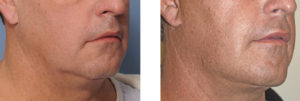Recent stories have surfaced that the actor, Michael Douglas, has had a facelift. Based on what are perceived to be scars at or around the ears, reporters are questioning as whether he had had this plastic surgery procedure. Given that many celebrities and ordinary men have facelifts, I am not sure what makes this story news worthy. But the story does raise important issues about the male facelift and the objectives of any facelift surgery.
Facelift surgery for men is becoming more commonplace today. Men are becoming increasingly desirous of a more youthful and attractive appearance in both the business and social world. As the popularity and commonality of plastic surgery in general has risen, so has it also become more acceptable for men to be concerned with their appearance as well. In my Indianapolis plastic surgery practice, I am seeing more men than ever who do not like the appearance of their sagging necks and jowls.
The goals of a male facelift are certainly similar to that of a conventional facelift for women. In both, a refreshed and rejuvenated facial appearance is desired. Equally so, however, is a natural and unoperated look afterwards. The overall strategy for achieving such results is gender identical, including the lifting and tightening of loose jowl, neck, and lateral face skin as well as the removal of neck fat and the tightening of the platsymal neck muscle. However, a facelift in men requires the consideration of some different techniques to get the most non-conspicuous result.

The key decisions to make about this incision placement is whether to use a preauricular (along the natural skin crease in front of the ear) or a retrotragal (bringing it inside the ear) location. The retrotragal approach hides the incision better but requires beard management, either removing hair follicles during or after surgery. There are plastic surgery advocates for both approaches. Also, how and where the backcut of the incision on the back of the ear is made is also of cosmetic significance. Not having a visible scar extending from behind the ear into the scalp which is not seen from the side or back is important. Limiting this incision so that it can be better hidden (keeping it in the crease) also influences how much neck improvement can be obtained.
Men also have more blood vessels in their face than women as well as a higher incidence of high blood pressure. This combination means that the risk for bleeding after surgery and getting a hematoma is higher. Pain control, blood pressure management and a good dressing are very important immediate after surgery precautions that need to be done.
Lastly, successful male facelift surgery to me is one in which it is not obvious that the procedure was done. Mild to moderate neck and jowl improvement that is not unusual looking is more important than a more significant improvement that looks unnatural. A common problem in men that have multiple facial plastic surgery procedures is that the male face can become feminized, looking too angular or defined.
Dr. Barry Eppley
Indianapolis, Indiana


